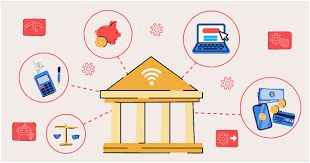Hello!
AI is constantly evolving. Already, financial institutions are using AI technology to detect fraud and other unusual transactions, personalize services, make credit decisions, and use natural language processing on text documents.
 Banks have improved their customer service over the years. Modern technology has been tailored to their specific work. In 1960, the first ATMs were built. Ten years later, payment and transaction cards were available.
Banks have improved their customer service over the years. Modern technology has been tailored to their specific work. In 1960, the first ATMs were built. Ten years later, payment and transaction cards were available.
Users first learned about online banking at the start of this century. In 2010, mobile banking was introduced to them. The digital age opens up new opportunities for the financial system.
Artificial Intelligence is being used in banks and financial institutions. Banks are expected to save $447 billion annually by implementing AI applications. Below are some fine examples.
Mobile banking
Mobile apps with AI are becoming more personalized, proactive, and advanced. One Canadian Bank, for example, has Siri built into its iOS app. To send money to another card, you can simply say “Hey Siri, send $20 Alex!” Touch ID to confirm the transaction.
 AI has allowed banks to generate 66% more revenue through mobile banking than when customers visit branch branches. To improve the quality of their services and stay competitive in the market, banks are closely monitoring emerging technology.
AI has allowed banks to generate 66% more revenue through mobile banking than when customers visit branch branches. To improve the quality of their services and stay competitive in the market, banks are closely monitoring emerging technology.
Also read: How to Start An E-commerce Business From Scratch
AI Chat Bots
Chatbots are AI-enabled conversational interfaces. This is the most common use of AI in banking. Without requiring significant expenses, bots can communicate with customers for the bank. Research shows that chatbots save financial institutions four minutes per communication.
Banks embed chatbot services into mobile apps because customers often use them to make monetary transactions. This allows banks to grab customers’ attention and establish a brand that is easily recognized in the market.
 Cuba ChatBot was launched by the Australian Commonwealth Bank. It has been a huge success. It helped more than 500,000 customers solve their banking problems: activate their cards and check their account balances. They could also withdraw cash.
Cuba ChatBot was launched by the Australian Commonwealth Bank. It has been a huge success. It helped more than 500,000 customers solve their banking problems: activate their cards and check their account balances. They could also withdraw cash.
Bank of America also launched a chatbot that sent out notifications to users, informed them about their balances, and made recommendations for saving money. It also provided updates on credit reports and gave them updates. This is how the bank assists its clients in making informed decisions.
Data collection and analysis
Every day, banks record millions of transactions. Banks generate a lot of information every day. This makes it difficult for employees to collect and register the data. It is difficult to organize and record this data without a plan. It is difficult to determine the relationship between the data, especially when there are thousands of clients.
 The old approach was to invite a client to meet with a bank representative who knew their financial history and could explain the options available to them. That’s all history.
The old approach was to invite a client to meet with a bank representative who knew their financial history and could explain the options available to them. That’s all history.
Banks are now trying to use the abundance of data from transactions to develop innovative business ideas and risk management strategies.
AI-based apps analyze and collect data. This enhances the user experience. This information can be used to grant loans or detect fraud. Big Data analysis has led to an average increase of revenue by 8%, and a decrease in costs by 10% for companies that have estimated their profits.
Risk management
Bankers find it difficult to extend credit. Banks that lend money to insolvent customers can run into trouble. A default occurs when a borrower loses their steady income. Statistics show that in 2020, U.S. credit card delinquencies rose by 1.4% in six months.
 AI-powered systems can accurately assess customer credit histories to prevent default. Mobile banking apps can track financial transactions and analyze data. This allows banks to anticipate risks when issuing loans such as customer bankruptcy or fraud.
AI-powered systems can accurately assess customer credit histories to prevent default. Mobile banking apps can track financial transactions and analyze data. This allows banks to anticipate risks when issuing loans such as customer bankruptcy or fraud.
Transaction Data Enrichment
Both financial institutions, as well as consumers, must be able to manage their finances. It uses machine learning and AI to decipher strings of characters that are not understandable.
This text is converted to readable text and shows the merchant’s name, address, and city. This shows the location of the local merchant, not the corporate headquarters. This is a way for customers and banks to easily understand the data and where it was spent.
Because customers know what they purchased and where they bought it, this reduces customer service calls as well as fraud research costs.
 Because they can understand the meaning of mystery charges on their credit cards, fraud detection decreases the number of people calling about it. This reduces fraud research costs and results in fewer calls.
Because they can understand the meaning of mystery charges on their credit cards, fraud detection decreases the number of people calling about it. This reduces fraud research costs and results in fewer calls.
These clear descriptions allow developers to place financial data in context, allowing them to more easily categorize purchases and analyze them. This is useful for things like budgeting, credit scoring, and analyzing spending habits.
Data security
According to the Federal Trade Commission’s 2020 report, credit card fraud is the most prevalent type of personal data theft.
AI-based systems can be used to stop wrongdoers. These programs monitor customer behavior, financial habits, and location and activate security mechanisms if they find unusual activity. ABI Research projects that cybersecurity analytics and AI will be worth $96 billion by 2022.
 Amazon acquired harvest.AI, an AI cybersecurity startup and launched Macie, a service that uses Machine Learning to detect and sort data in S3 Cloud Storage.
Amazon acquired harvest.AI, an AI cybersecurity startup and launched Macie, a service that uses Machine Learning to detect and sort data in S3 Cloud Storage.
Closing Note
There are many ways that AI can be applied in the finance sector. According to the OpenText survey, almost 80% of banks recognize the benefits of AI, 75% of them already make use of this technology, and about 46% plan to implement AI-based systems in the near future.
AI-powered solutions are an integral part of companies’ development plans, helping them remain competitive on the market. This technology reduces operating costs, improves customer service, and automates processes.
Thank you!
Subscribe to our newsletter! Join us on social networks!
See you!






